|
The
Monte Carlo Story
Mini
– winning the Monte Carlo Rally
40 years ago
Source: Mini
The Beginnings...
It certainly was the sensation in the
1963/64 winter rally season: A small red
David with a white roof proudly showed
its tailpipe to all those ultra-powerful
Goliaths, clinching overall victory in
the Monte Carlo Rally. And in this 'big
bang', the tiny little car immediately
became a legend: Originally conceived
as an inexpensive and economical means
of transport, the Mini had been transformed
into the hot-blooded Mini Cooper now clearly
standing out as the 'small man’s
sports car'. Wherever the Mini –
either in standard trim, as the Cooper
version, or in highly modified form –
appeared at the start of a race, it was
always good for a genuine surprise. Indeed,
the Mini wrote many a headline in the
world of rally racing, just like it made
times more than difficult for the usual
'strong guys' on race circuits the world
over. The 1960s, therefore, were the decade
of the Mini, far beyond official races
and competitive events alone. For even
when the Mini started to feel keen competition
on closed circuit tracks, there was still
no other car in the market able to offer
the same kind of sporting performance
for so little money, providing outstanding
driving pleasure within such compact dimensions.

Forty
years on nothing has changed
The features which once took the Mini
Cooper to victory in that historic race
to Monaco remain the basic ingredients
of the MINI Cooper today. With its compact
exterior dimensions, the new (BMW) MINI
Cooper simply whisks around corners, resting
solidly on its wide track and long wheelbase.
Indeed, this kind of driving behaviour
clearly calls for sporting performance,
the John Cooper Challenge Brand Trophy
attracting an increasing number of motorsports
aficionados particularly in Britain, the
home country of the MINI. And like their
fathers 40 years ago, many aspiring talents
and up-and-coming racing drivers gain
their first experience and bring home
their first trophies at the wheel of a
MINI.
In
particular, however, every driver given
the opportunity to take the wheel of a
MINI will feel right away precisely why
entering the Monte Carlo Rally would indeed
be a wonderful experience. And nobody
can express this feeling more appropriately
than Rauno Aaltonen, the 'Flying Finn':
"Both generations of the Mini clearly
stand out from all other cars in precisely
the same way. They are extremely agile
and follow the steering immediately. Back
then the Mini was a Princess, beautiful
and full of character. In the meantime
the Princess has grown up, and the new
MINI has become a Queen!"
A
small car coming out big: Mini and the
Monte Carlo Rally
The
Mini was simply perfect for rally racing
right from the start, six works cars making
their appearance in the 1960 Monte Carlo
Rally just six months after the Mini had
made its debut in the market. Private
drivers entered six more of these brand-new,
small but mighty performers. Back then,
however, the newcomer was not yet particularly
competitive, Riley/Jones finishing 23rd
in the fastest Mini. A year later the
small cars from Britain were not successful,
either, none of the three works cars entered
in the race reaching the finish line.
All this changed dramatically in 1962,
when Rauno Aaltonen, the Flying Finn,
entered the spectacular Rally for the
first time at the wheel of a Mini Cooper.
Unfortunately, this very nearly might
have been his last Rally, too, with his
car rolling over in an accident, landing
on the roof and catching fire. Aaltonen
just had a few seconds to get out before
his Mini became a complete victim of the
flames.
Only two other works Minis remained in
the race, finishing the Rally as No 26
and 77. But two more names also appeared
in the list of entrants, destined to hit
the headlines in the not too distant future
together with the MINI: This was the year
in which Timo Mäkinen entered Monto
Carlo the first time in a Mini Cooper,
albeit as a private driver. And the Sunbeam
Rapier finishing third overall was driven
by an Irishman called Patrick Hopkirk.
1963:
first class win for the Mini Cooper
Just a year later Paddy Hopkirk was back,
this time at the wheel of a Mini Cooper,
with four works cars entering the famous
Rally in 1963. The most successful Mini
driver was Rauno Aaltonen clinching victory
in his class and finishing third overall.
Paddy Hopkirk followed as second in his
segment and finished sixth in the overall
rating, the two other Mini Coopers raced
by the works team finishing 28th and 44th.
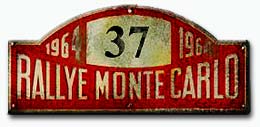
1964
Monte Carlo Rally: How the Mini Cooper
became a Legend
The
Rally promised to be more exciting than
ever this year. And what had become increasingly
evident in the years before then became
a clear fact on 17 January 1964: The era
of the amateurs was coming to an end,
with more and more works teams now entering
the Monte Carlo Rally. Starting out in
Minsk, Glasgow, Paris, Frankfurt, Athens,
Warsaw, Lisbon, and Monaco, the latter
naturally also marking the finish line,
the teams are really a colourful group.
The ultra-powerful Ford Falcons with Greder/Delalande
and Schlesser/Leguezec at the wheel are
matched, at best, by the Mercedes-Benz
300 SE driven by Böhringer/Kaiser
and Glemser/Braungart. But Trana/Lindstrom
at the wheel of a Volvo 544 also expect
to look good, just like Toivonen/Jarvi
in their Volkswagen 1500. Citroën
enters no less than four DS 19s, but in
terms of sheer numbers still lags behind
the British, BMC alone registering an
astounding six ultra-quick and nimble
Minis, with 24 more Minis being raced
by private teams. Mini drivers Patrick
Hopkirk and Henry Liddon set out on the
Rally in the Russian city of Minsk together
with another Mini team, whilst Rauno Aaltonen
and Tony Ambrose start their trip to the
south of France in Oslo. The three other
Minis, one of them driven by Timo Mäkinen
and Patrick Vanson, start the Rally in
Paris, heading for their first interim
destination in Reims.
Newer,
stronger, faster: the Mini Cooper S
Precisely this combination of teams in
the armada of Minis promises to be really
exciting: Last year Aaltonen and Hopkirk
finished first and second in their class,
the Flying Finn even clinching third place
overall. And this year they are entering
the race with a new and even more powerful
car: The model they had raced before was
a production Mini developing 56 bhp from
997 cc, and with top speed of 140 km/h
or 87 mph. This year the Minis entering
the race are the new Cooper S with a larger
engine displacing 1,071 cc and developing
maximum output of 70 bhp. Not only the
higher top speed of 160 km/h or 99 mph
promises to make the Mini more competitive,
but also – and, indeed, above all
– much faster acceleration to 100
km/h in 13 instead of 19 seconds.
The Rally starts out very well for the
drivers in their ultra-compact but very
roomy racing machines: The average speed
of all cars on their 4,000-kilometre trip
to Reims is 50 km/h or 31 mph, with only
277 cars reaching this first destination
– all the works Minis among them.
Then, in this famous French city, the
race officials carefully make a note of
the number plates on the three red Minis
with their white roofs destined to become
a legend: 33 EJB driven by Paddy Hopkirk,
LBL 6D with Rauno Aaltonen at the wheel,
and AJB 44B piloted by Timo Mäkinen.
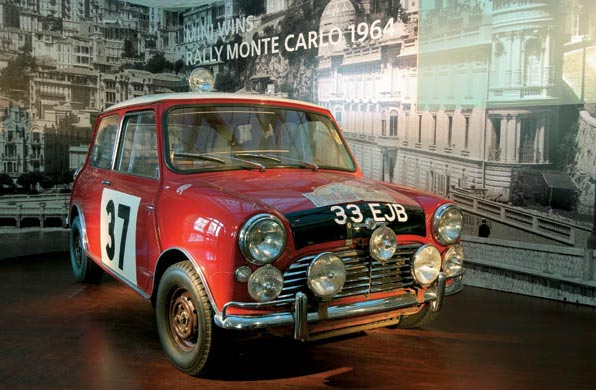
Paddy Hopkirk &
Henry Liddon's 1964 Monte Carlo Rally
Winning Cooper
- at the Gaydon Museum of the British
Motor Industry
A
promising start: Paddy Hopkirk finishes
second
The first leg of the Rally now comprising
all teams is to Saint Claude, with a distance
of 597 kilometres or 370 miles. After
the 23-kilometre special trial between
Saint Didier and Mont Main, the Ford Falcons
with their mighty 4.7-litre 8-cylinder
power units appear to confirm their leading
role, Bo Ljungfeldt ranking No 1 in his
muscle machine, but with Patrick 'Paddy'
Hopkirk only 16 seconds behind in his
Mini Cooper S. No 3 is Eugen Böhringer
in his Mercedes 300 SE, and Trana in a
Volvo 544 is in fourth place. The second
Mini Cooper with Timo Mäkinen at
the wheel is No 5.
Hanging
on there with full throttle
Still – the nimble Minis do not
have a very good chance of keeping these
leading positions, since they are simply
not built for very high speeds. And the
next leg of the race from La Madelaine
to Pelle Autiers near Gap is a 46-kilometre
full throttle trial, which is reflected
by the ranking at the end of the day:
Ljungfeldt remains in the lead with his
fast American Falcon, Trana is now in
second place in his 'humpback' Volvo.
But the Minis put up a tremendous show
all the same, Paddy Hopkirk dropping back
only one place to No 3 in his Mini Cooper.
Mercedes driver Eugen Böhringer is
No 4, and Timo Mäkinen is able to
hang on to fifth place.
Final
decision in the 'night of long knives'
Entering the decisive and most demanding
trial, the teams use all their resources
and special ploys to achieve the best
possible result:'Ice scouts' drive the
same route as late as possible prior to
the start of the race in order to warn
the drivers of critical spots. The tyre
game is also a dominating factor, some
teams relying on spikes, others on compounds.
Super low-section tires with asymmetric
tread serve to provide optimum traction,
some of the other tires used are in semi-radial-ply
design. And the first Dunlop low-section
racing tires also make their appearance
this year. Prior to the 'night of long
knives', Ljungfeldt’s Goliath is
65 seconds ahead of the 'Davids' in their
Minis. But now Ljungfeldt’s large
engine is a disadvantage, since the rule
in the Monte Carlo Rally is that drivers
with larger engines have to drive faster
to avoid penalty points. So Bo Ljungfeldt
hurls his car through the serpentines
up to Col de Turini at an altitude of
1,607 metres or 5,271 feet – but
the weight of his Ford Falcon, the sheer
size of the car and rear-wheel drive prove
to be a disadvantage on deep snow. The
small Mini Coopers, in turn, more than
compensate their lack of power through
their nimble handling in bends combined
with front-wheel drive.
Reaching
the finish line, Ljungfeldt is now only
17 seconds ahead of Hopkirk. And according
to the handicap formula, the Irish driver
is now in the lead in his Mini Cooper
with 2,152.1 penalty points. No 2 is Saab
driver Eric Carlsson with 2,183.2 points.
Mäkinen has also moved up one place,
2,216 points putting him just 0.2 points
ahead of Ljungfeldt. Thirty points for
victory: Paddy Hopkirk wins the Monte
Carlo Rally. The only chance the Ford
Falcon driver now has for victory is to
win the final circuit race on the Grand
Prix city track in Monaco included for
the last time this year in the Monte Carlo
Rally. But this remains only a theoretical
option: Bo Ljungfeldt pushes the Falcon
round the circuit as fast as he can, with
only Schlesser being able to keep up.
But Paddy Hopkirk doesn’t give the
Mini Cooper a rest, either, finishing
only half a minute behind Ljungfeldt and
thus clinching victory in the 1964 Monte
Carlo Rally. So at the end of the race
Paddy Hopkirk is the winner with 2,536.2
points, Bo Ljungfeldt finishes second
with 2,566.7 points, and Carlsson is third
with 2,573.7 points. To round off the
Mini Coopers’ triumphant appearance,
Mäkinen is fourth with 2,593.8 and
Rauno Aaltonen 6th with 2,619.5 points.
The works strategy has therefore proven
successful in every respect, Paddy Hopkirk
and his two Scandinavian colleagues forming
a joint team for the first time. At the
end of the Rally the spectacular and eye-catching
style of all three drivers shows everybody
that these really must be the Three Musketeers.
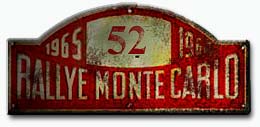
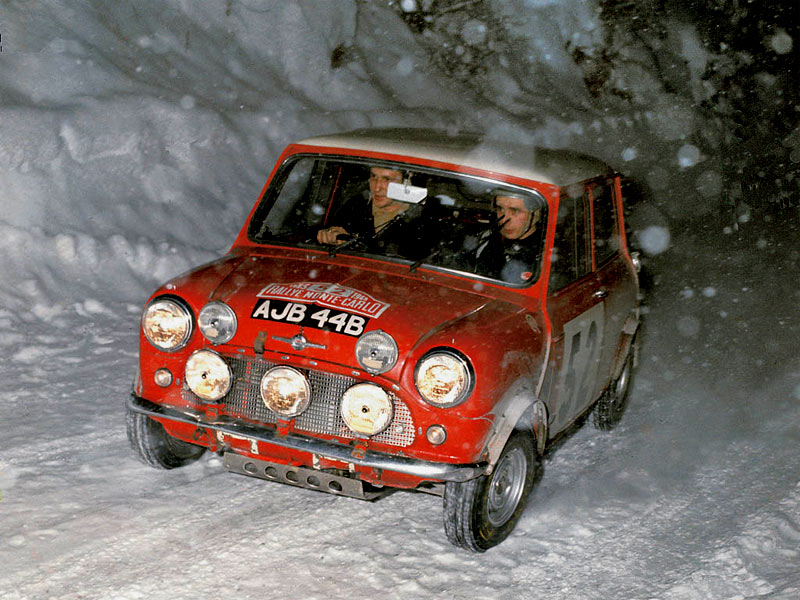
Win
in '65
In 1965 Timo Mäkinen from Finland
continued the Mini Cooper’s story
of success together with co-driver Paul
Easter, bringing home a supreme victory
in the Monte Carlo Rally as the only driver
in the entire field to cover thousands
of kilometres without one single penalty
point despite very difficult snow conditions
in the French Alps. This was Mäkinen’s
first outing in a Mini Cooper with the
new 1,275-cc power unit destined to become
a synonym for this model. Mäkinen
himself had set out from Stockholm together
with Paddy Hopkirk, two other cars coming
from Minsk and one each from Paris and
Athens. Hopkirk finished the Rally in
26th place, closely followed by the two
brothers Eric and Donald Morley forming
another works team.
It was also in 1965 that BMC gave up an
old tradition for the first time, the
works Mini Coopers boasting tartan-red
paintwork with a white roof right from
the start. The only exception was the
Swedish team Kallström/ Haakansson
driving a green rally car with a white
roof.
1965: only 35 out 237 cars reach the finish
line– among them three Mini Cooper
S’s. Leaving aside the 1952 Monte
Carlo Rally when there was nothing but
snow and ice in the Alpes Maritimes, weather
conditions in 1965 were acknowledged as
the most difficult ever. And instead of
the final circuit race on the Formula
1 track to Monaco, the teams now had to
go back to the mountains a second time,
the rally cars being required to cover
610 kilometres or 378 miles in a second
tormenting night drive from Saint Claude
to Monte Carlo, again racing through the
Alpes Maritimes under the toughest conditions.
Visibility in dense snowfall was almost
zero and the drivers were dazzled by their
halogen headlights reflected by the snow
and ice, so that ultimately only 35 out
of the original 237 teams saw the chequered
flag. Facing this kind of challenge, Mäkinen
put up an amazing performance, achieving
the fastest time in three out of five
special trials on the last, ultra-difficult
legs of the race. Entering the last night
eight minutes in the lead, Mäkinen
won no less than five out of six special
trials in this final part of the Monte
Carlo Rally.
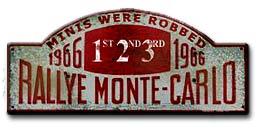
A
dicey decision in 1966: the winner –
but disqualified
In
1966 the Mini armada went for their hat
trick, the four Cooper teams being acknowledged
as the favourites in the race and receiving
lots of public interest. From the start,
the teams lived up to this commitment,
Mäkinen, Aaltonen and Hopkirk leaving
all the others far behind and finishing
first, second and third at the end of
the Rally. But then came one of the most
questionable decisions in the history
of the Monte Carlo Rally, the race commissioners
determining in an 8-hour technical inspection
after the event that the four additional
headlights mounted on the radiator grille
of the Mini Coopers failed to comply with
French homologation rules. And proceeding
from this highly debatable point, the
jury disqualified the first three cars.
With the Lotus Cortina finishing fourth
being disqualified for the same reason,
Citroën driver Toivonen finally moved
up to the top of the podium as the winner.
|
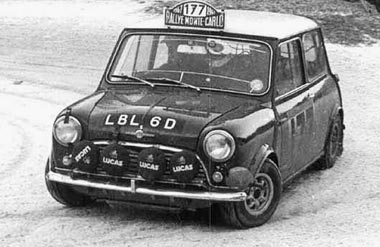
LBL 6D - The 1967 winner |
Back
again in '67, and won
Notwithstanding this bitter experience,
the Mini Coopers were back in the 1967
Monte Carlo Rally, the Three Musketeers
Aaltonen, Hopkirk and Mäkinen being
joined by Simo Lampinen and Tony Fall.
Entering the event with starter number
177, Rauno Aaltonen/Henry Liddon finally
ended up in first place, 12 seconds faster
than the Lancia finishing second. All
other Mini Coopers likewise saw the chequered
flag, Hopkirk finishing 6th, Fall 10th,
Lampinen 15th, and Mäkinen 41st.
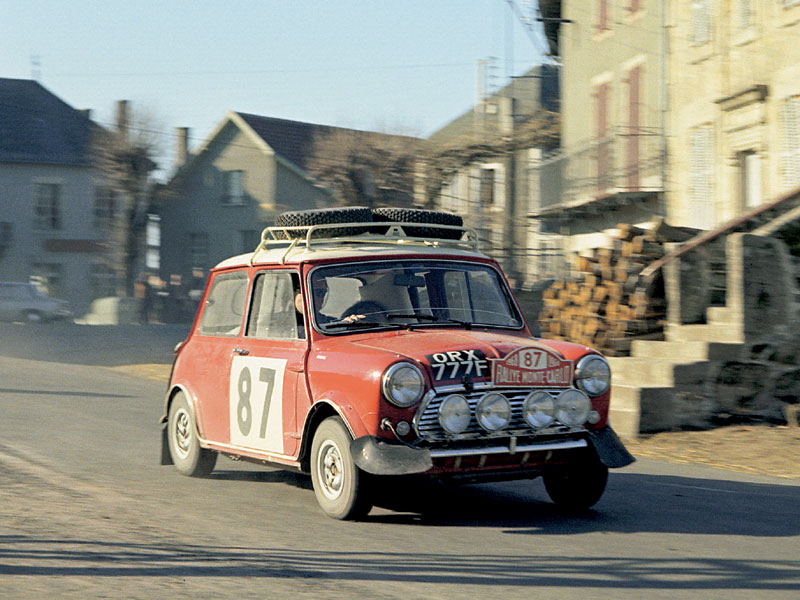
Paddy Hopkirk's 1968 Monte Carlo Rally
5th Place Cooper S
1968, Mini's reign
over
1968 was the last time the works Mini
armada set out for Monaco, Aaltonen finishing
third in his Cooper S, Tony Fall coming
in fourth and Hopkirk finishing fifth,
while Mäkinen was No 55 at the finish
line. Despite these excellent results
scored once again, it was clear at the
time that the Mini Cooper S had passed
its pinnacle as a rally car. The legend,
however, lived on even after the era of
the Mini Cooper had come to an end. And
to this very day every rally enthusiast
knows the meaning of '33 EJB'– the
number plate on Paddy Hopkirk’s
Mini Cooper S, the winner of the 1964
Monte Carlo Rally.
Back
to Top
|